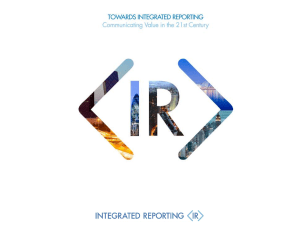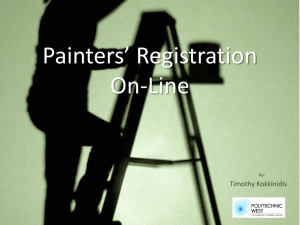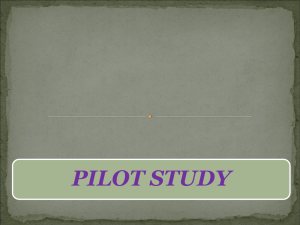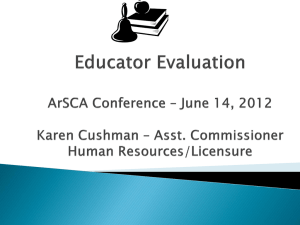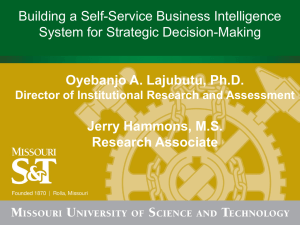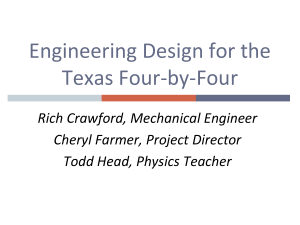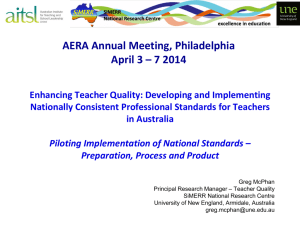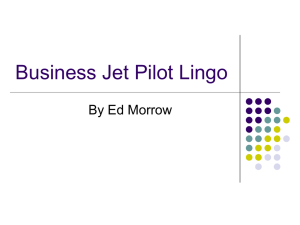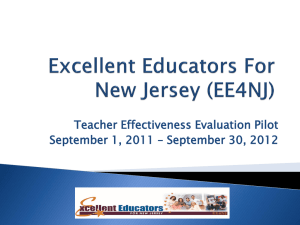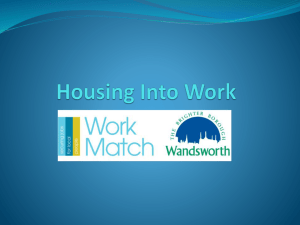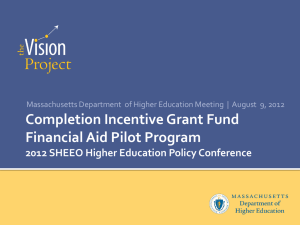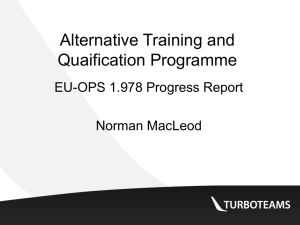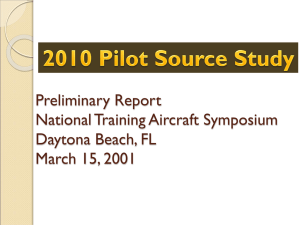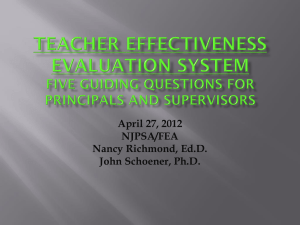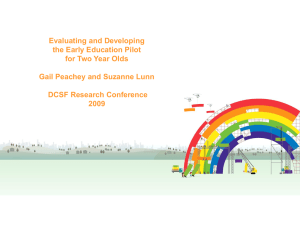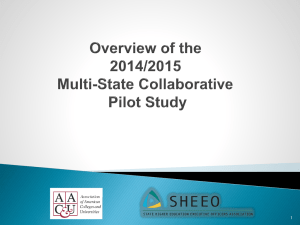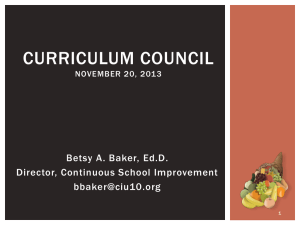Chancellor Walcott`s PowerPoint
advertisement
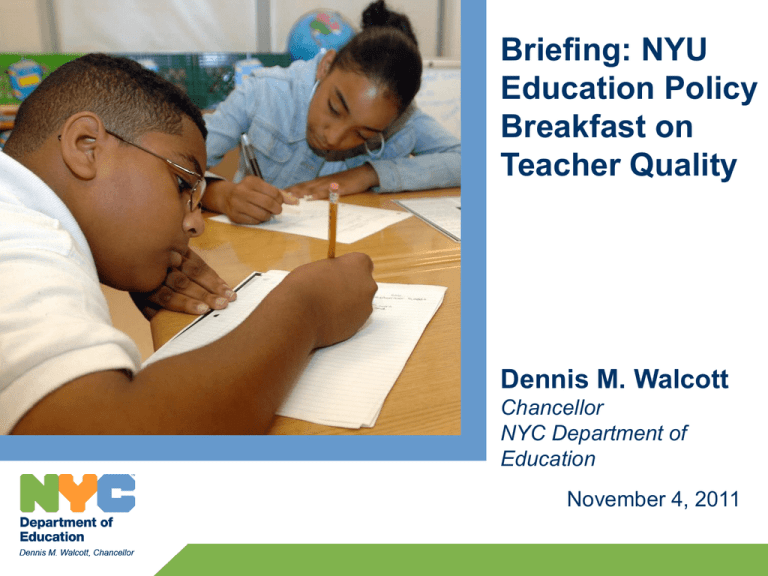
Briefing: NYU Education Policy Breakfast on Teacher Quality Dennis M. Walcott Chancellor NYC Department of Education November 4, 2011 Overall Goal Improved teacher practice and school leader effectiveness Improved student outcomes College and career readiness for all students 2 New York State Education Law 3012-c requires significant changes to the current evaluation systems for teachers and principals Summary of State Policy on Teacher & Principal Evaluation • 4-point rating scale (Highly Effective, Effective, Developing, Ineffective) • Use student growth as a criteria • Uniform qualitative rating criteria • Timely and constructive feedback • Implemented in Transformation/Restart Schools in 2011-2012 • Teacher Evaluation being piloted in 107 schools; School Leader Evaluation being piloted in 30 schools 3 A priority for New York City is to ensure that all students graduate high school college and career ready. We can help to realize this priority by improving student outcomes and educator practice 2 Boost effectiveness of all educators GOAL 1 Retain and leverage the most effective educators 3 Improve or counsel out persistently less effective educators Teacher and Principal Effectiveness (Student Outcomes, Instructional Practice) 4 Why Teacher Evaluation Matters Emerging research indicates that rigorous teacher evaluations can improve teacher performance in significant, measurable and enduring ways > According to a 2011 study of Cincinnati Public Schools’ Teacher Evaluation System (TES), “high-quality, classroom-observation-based evaluation improves midcareer teacher performance both during the period of evaluation and in subsequent years,” as measured by increases in student achievement growth in math. (Taylor and Tyler 2011) Teachers who are not meeting expectations can improve, but not without honest feedback > When teachers get constructive critical feedback and concrete suggestions for improvement, they can provide better instruction for their students and enjoy more positive experiences in the workplace. According to a 2011 study of mid-career educators, the least skilled teachers benefit most from thoughtful evaluations, and those instructors who make the greatest improvement after evaluations are least likely to leave the classroom. (Taylor and Tyler 2011) *Students assigned to a teacher after she participates in TES score about 10 percent of a standard deviation higher in math than similar students taught by the same teacher prior to TES participation. 5 Why we need a new teacher evaluation system: School Perspective Current System Doesn’t Promote Effectiveness • Lack of clear expectations for practice • Evaluation criteria often has no impact on driving student achievement • Teachers don’t consistently receive sufficient or actionable feedback • No differentiation between teachers – about 98% of teacher receive satisfactory evaluations Survey Responses from NYC Teachers • Fewer than 40% of teachers who responded to the survey agreed that current evaluation ratings are accurate reflections of teacher effectiveness • Only 29% felt the current S/U evaluation system helped teachers to improve their instructional performance by providing specific and useful feedback • More than half of teachers who responded said they do not get enough feedback, and nearly three in four teachers indicated that the feedback they do get, does not help them improve • Nearly three quarters of teachers do not think that the evaluation process helps poor-performing teachers improve Source: 2010-2011 Teacher Beginning of Year Survey in 19 Pilot Schools – 42% response rate 6 2011-12 Teacher Evaluation Initiatives 2011-12 Talent Management Pilot • 107 schools in all 5 boroughs, diverse range of student demographics • Builds on work of 2010-11 Teacher Effectiveness Pilot (20 schools) • Goals: • Build capacity of teachers & leaders to improve student learning, and of networks to support this work • Prepare for full-scale rollout of new teacher evaluation system in future years aligned with 3012-c requirements • Evaluations are “low-stakes” during pilot year • We are researching the pilot to improve implementation and to measure outcomes for a full scale roll-out Transformation & Restart Schools • 33 schools required to implement a new model of teacher evaluation and development aligned with 3012-c as a condition of federal School Improvement Grant funding • “For-stakes” implementation of new evaluation system 7 The teacher evaluation framework introduced through the pilot will incorporate multiple measures of teacher effectiveness. Measures of Teacher Competencies (60%) Measures of Student Learning (40%) Classroom Observation School-Defined Option Local Measures (50-60%) (0-10%) (20%) • Frequent classroom observations by school leaders to assess teachers’ professional skills, behavior, and knowledge aligned with the modified Danielson rubric or other networkselected, centrally approved rubric • School can determine a custom measure to include in the evaluation framework • Depending on grade & subject, teachers will pilot performance task assessments, computer adaptive assessments, group measures, or common assessments • Examples include: additional Danielson competencies; positive contribution to school and/or community, and; student feedback Student Growth Measures (20%) • For grades 4-8 ELA & Math, teacher growth scores on state tests • For other grades with a state test, growth measures / goals based upon those assessments • For other grades, one of the local measure options Note: In collaboration with Talent Coaches, some schools may decide not to implement measures of student learning in some grades/ subjects. Measures used in the pilot will align with the recently adopted New York State regulations on teacher evaluation 8 School Leader Perspective: Teacher Effectiveness Pilot Year One* • 91% of school leaders agreed that implementing the pilot model at their school enabled their teachers to develop professionally in the areas most needed to impact student achievement outcomes. • School leaders’ confidence in their ability to deliver critical feedback based on rigorous performance standards increased over the course of the pilot. • Pre-pilot: 35% of school leaders felt confident or very confident • Post-pilot: 82% of school leaders felt confident or very confident • 88% of Principals strongly agreed or agreed that their Talent Coach provided them with the support they needed to do this work well. • “I am a better supervisor due to this experience.” • “This was one of the most challenging things I have done in my three years as a principal. On the positive side, my administrative team can now use a common lens through which to observe teacher practice and help to move teacher and student performance.” *Source: 2010-11 School Leader End of Year Survey; 80% response rate 9 Teacher Perspective: Teacher Effectiveness Pilot Year One* • Pilot participation influenced a large majority of pilot teachers to critically evaluate their own professional practice and seek improvement. • 77% of pilot teachers agreed that they have already begun thinking about how to improve their use of assessments for next year as a result of the pilot. • 72% have already begun thinking about ways to improve their instructional practice as a result of observations and feedback this year. • Teachers remain convinced that meaningful evaluations are important. • Pre-Pilot: 87% of teachers agreed that “All teachers should receive annual summative evaluation ratings that are clear measures of their performance as teachers.” • Post-Pilot: 94% of teachers agreed with the statement. • Teachers believe that receiving regular feedback on their practice is important. • Pre-Pilot: 45% indicated they currently received enough feedback on their practice. • Post-Pilot: 80% felt that all teachers should receive feedback on their teaching practice throughout the year *Source: 2010-11 Teacher End of Year Survey; 329 respondents 10 QUESTIONS & ANSWERS 11

